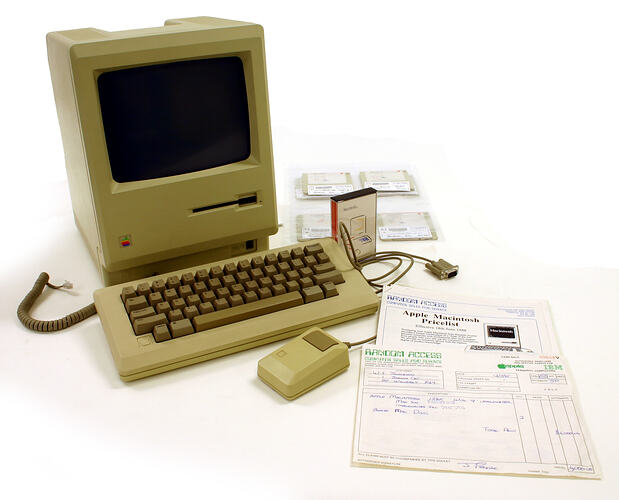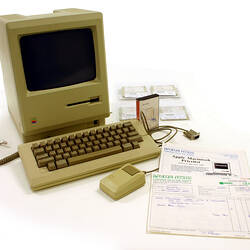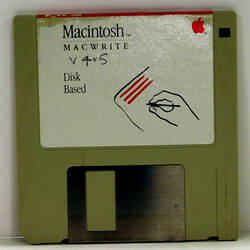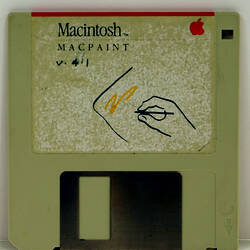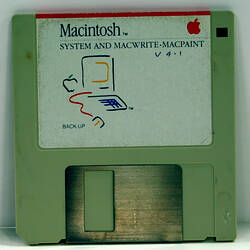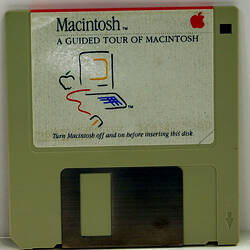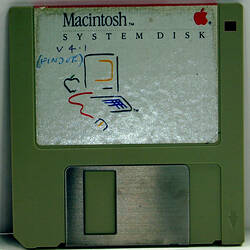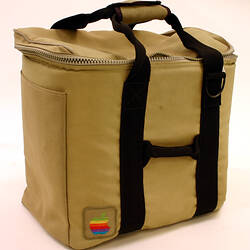Summary
The 'Macintosh 128k' is a compact computer system with a self-contained monitor and floppy disk drive.
It came with the MacWrite word processing software and the MacPaint 'painting' software, both of which were outstanding pieces of software at that time that took advantage of the new graphical user interface.
Also bundled with the computer was an innovative system for helping the user to learn how to use the computer and its wordprocessing and 'painting' software. This was a floppy disk titled 'Macintosh MacWrite MacPaint A Guided Tour', which was used in conjunction with an audiotape titled 'A Guided Tour of Macintosh and MacWrite MacPaint.The Guided Tour is significant in that Apple was using innovative means to make the computer accessible to a mass market.
The receipt that accompanies the computer system is dated July 1985 and is for AUD$4,000.00.
The 'Macintosh 128k' was announced on 22 January 1984 at the American Superbowl with the showing of the highly acclaimed single minute long allegedly best ever '1984' advertisement 'Blade Runner':Gladiator, which did not show the product! The Macintosh was released two days later on 24 January 1984.
Together with the Lisa, released in 1983, the 128k Macintosh was innovative in many respects, but three stand out: the white screen display, the graphical user interface and the mouse. The paper white display showed exactly what would be printed. Other computers of the time showed green characters on black screens in a mono typeface which indicated formatting with various complex codes. The mouse enabled control of the graphical user interface we now take for granted, consisting of windows, icons and menus. The integrated graphical user interface and mouse system has been called Windows, Icons, Menus and Pointing device, and dubbed WIMP. These major innovations remain to this day, and the Macintosh was the computer that successfully helped to popularise them. In essence, the Mac was Apple's attempt to make computing a simple, user-friendly activity allowing its users to exploit their creativity in profound and hitherto prohibitively expensive means, previously requiring high end professional equipment.
The 128k Macintosh was the first commercially successful personal computer to feature a mouse and a graphical user interface rather than a command line interface.
Despite the now universal adoption of the graphical interface as an industry standard, it was criticised by proponents of rival command line interfaces, until they bowed to public demand and produced graphical user interfaces of their own. Although Microsoft had launched its operating system - MS DOS - in 1981 it was not until 1985, a year after the Macintosh made its debut, that it introduced its own GUI, Microsoft Windows. However, this did not enjoy significant popularity until the advent of Windows 3.x in 1990.
The Macintosh used an 8MHz Motorola 68000 chip, 128k RAM, a 400k floppy drive, an external port for another disk drive, mouse, keyboard, audio and two serial ports.
Memory was so expensive that it cost over AUD$1,000 to upgrade the original 128k Mac to a 512k Fat Mac.
In July 1985 the donor purchased this Macintosh 128K with a nine inch ImageWriter printer. He says that he was instantly impressed with its different and innovative approach to personal computing, and in particular with the intuitive design of the operating system and applications. In late 1985 he saw the new Hard Disk 20, with what seemed a limitless 20 Mb capacity, which provided sufficient storage for the newsletter which he produced in his spare time for a group interested in old Italian motor cars. At work with a telecommunications authority he also used a Macintosh, where its use was primarily word processing and for spreadsheets, with the newly arrived Microsoft Excel. He says that it was this original 128K Mac which introduced him to the Macintosh philosophy, which surprised and delighted him the first time he used 'such a versatile and capable instrument'.
Part of a representative collection of hardware, software, trade literature and promotional material that documents the history of the Apple company, and its contribution to, and impact on the computer industry and society.
Physical Description
The personal computer system consists of: > Computer unit with inbuilt monitor > Macintosh QWERTY keyboard. with a detachable, expanable telephone cable and an added security lug. > 128K mouse, single rectangular button.and mouse. > Beige case, a fully self-contained computer, monitor with a 3.5 inch floppy drive built in (an indentation in the top of the case allows the computer to be lifted and carried). Also incuded are 3½-inch floppy disks holding software: > Macwrite v 4.5 software > Macpaint v4.1 software > System software, Startup > System software, Macwrite, Macpaint > Guided tour for Macwrite and Macpaint > Guided tour for Macintosh A ompact cassette tape with: > Guided tour of Macintosh, Macwrite and Macpaint. The items are accompanied by > Receipt for cash sale.(paper invoice printed in black text with green business names and logos) > Newsletter and four price lists from Random Access 1985-6
More Information
-
Collection Names
The Apple Company Collection, Internet Macintosh User Group (iMug) Collection
-
Collecting Areas
-
Acquisition Information
Donation from Bill Jamieson, 22 Nov 2006
-
Manufacturer
Apple Computer Inc, Cupertino, California, United States of America, 1984
-
Inscriptions
Computer: Front: Small coloured Apple logo under screen. Back: Coloured Apple logo. Macintosh Model Number M0001P Ke4yboard: On front - below left , Apple logo embossed. On underside, Apple Computer Inc." Hand engraved "V865113 P41" It is presumed that this is the drivers licence number of the donor. Model number, M0110 Serial number G501M011000794 Mouse: Front side Apple logo embossed. On underside, model number M0100, serial number G640MO10002212 Receipt supplied is dated October 1985.
-
Brand Names
-
Classification
-
Category
-
Discipline
-
Type of item
-
Overall Dimensions
247 mm (Width), 300 mm (Depth), 346 mm (Height)
Dimensions of main computer unit including monitor screen, but excluding keyboard, mouse and leads. See part records for further details.
-
Overall Dimensions
338 mm (Width), 170 mm (Depth), 60 mm (Height)
Depth measurement includes 25mm metal security tab. Cord length: 400 mm.
-
Part Dimensions
97 mm (Length), 62 mm (Width), 37 mm (Height)
Dimensions of mouse, excluding cable and connecting cables.
-
Keywords
Computer Hardware, Computers, Computing, Making History - Apple Computer Collection, Innovation & Design
